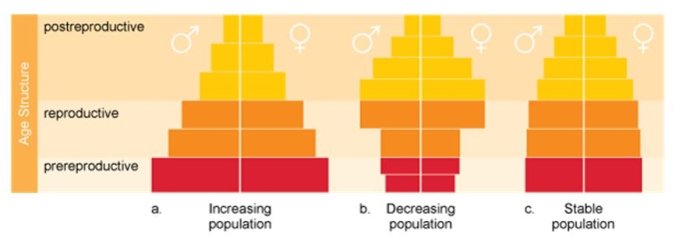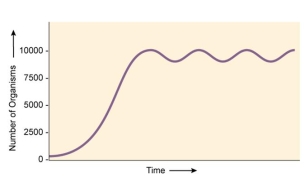A) clumped distribution.
B) density-dependent factor.
C) random factor.
D) density-independent factor.
E) biotic potential.
Correct Answer

verified
Correct Answer
verified
Multiple Choice
Meghan is studying interactions between caribou and their wolf predators. This is an example of _____ ecology.
A) population
B) community
C) ecosystem
D) biosphere
E) demographic
Correct Answer

verified
Correct Answer
verified
Multiple Choice
Which statement about ecology and environmental science is correct?
A) Ecology is a field of science that helps negate the information that is derived from the field of environmental science.
B) During the study of ecology, only living organisms are studied, while the nonliving aspects are studied within the field of environmental science.
C) During the study of environmental science, living organisms are studied, while the nonliving aspects are studied within the field of ecology.
D) The field of environmental science applies the ecological principles to human-based concerns.
E) The field of ecology focuses on human-based issues and uses them to help determine if there is going to be an environmental change.
Correct Answer

verified
Correct Answer
verified
Multiple Choice
Prairie dogs are highly social, burrow-dwelling rodents. Families have a strict social hierarchy and their "towns" can span hundreds of acres. In one colony, 750 animals live in a 500 m2 area. What is the population density?
A) 15
B) 1.5
C) 150
D) 2.5
E) 25
Correct Answer

verified
Correct Answer
verified
Multiple Choice
In European countries such as Italy, people are delaying childbirth and/or choosing to have no children or only one child. Which of the following age structure diagrams illustrates this type of trend? 
A) increasing population
B) decreasing population
C) stable population
D) This trend is not depicted in these diagrams.
Correct Answer

verified
Correct Answer
verified
Multiple Choice
In which of the following areas is human population growth the lowest?
A) Africa
B) North America
C) Australia
D) Europe
E) South America
Correct Answer

verified
Correct Answer
verified
Multiple Choice
What is the carrying capacity for the population of beetles indicated by the graph? 
A) ~ 5,000
B) ~ 10,000
C) ~ 100,000
D) ~ 2,500
E) cannot be determined from the graph
Correct Answer

verified
Correct Answer
verified
Multiple Choice
During a recent hurricane, 25 individuals of the same butterfly species were blown onto a barrier island in southern Florida. Prior to this event, this species did not inhabit the island, but with the ample vegetation on the island and a lack of predators, the displaced individuals were able to survive and reproduce. After several years, the population stabilized with approximately 150 individuals. The 150 individuals on the island is an example of the
A) density-dependent factors.
B) biotic potential.
C) exponential growth.
D) logistic growth.
E) carrying capacity.
Correct Answer

verified
Correct Answer
verified
Multiple Choice
Which of the following populations has the greatest biotic potential?
A) Population A in which females start to reproduce at 1 year and produce 2 offspring each year.
B) Population B in which females reach sexual maturity in 6 months and produce 1 offspring each 12-month reproductive cycle.
C) Population C in which males reach sexual maturity in just 3 months.
D) Population D in which individuals reach sexual maturity in 6 months and produce 5 offspring each year.
E) Population E in which individuals produce 20 offspring starting at 5 years of age.
Correct Answer

verified
Correct Answer
verified
Multiple Choice
Which of the following statements is correct about the comparison between MDCs and LDCs?
A) MDCs consume 4 times as many metals and 3 times as much paper as LDCs.
B) MDCs consume twice as much paper and 4 times as many metals as LDCs.
C) The population of MDCs is growing twice as fast as the population of LDCs.
D) MDCs produce 10 times as much hazardous waste and consume 3 times as much paper as LDCs.
E) MDCs consume 3 times as many metals and 4 times as much paper as LDCs.
Correct Answer

verified
Correct Answer
verified
Multiple Choice
Which of the following is an example of exponential growth?
A) 2,000→2,000→2,000
B) 1,500→1,600→1,700
C) 1,500→1,550 →2,010
D) 1,000→1,500 → 2,000
E) 2,000→1,500 →1,000
Correct Answer

verified
Correct Answer
verified
Multiple Choice
The growth rate continues to rise in some Asian countries. This is because
A) there is a higher number of reproductive individuals compared to postreproductive individuals.
B) there is a higher number of postreproductive and reproductive individuals compared to prereproductive individuals.
C) there is a higher number of prereproductive and reproductive individuals compared to postreproductive individuals.
D) there is an equal number of prereproductive and reproductive individuals.
E) there are more postreproductive individuals compared to prereproductive individuals.
Correct Answer

verified
Correct Answer
verified
Multiple Choice
Which of the following descriptions is not associated with the correct survivorship curve?
A) Black bear females usually produce just one cub. The cub nurses from the female for several months and can remain with the mother for up to two years. - Type I
B) Each spring an oak tree drops thousands of seeds, but only a few will ever reach sexual maturity. - Type III
C) Daphnia are planktonic crustaceans that produce offspring every three weeks. One Daphnia produces eight
Offspring, and after 1.5 weeks, four of these individuals are still alive. - Type II
D) Bald eagles return to the same mates and nests each year. They typically have two to three eggs and with parental care provided by both parents, the survival rate of the chicks is high. - Type II
E) As adults, female leatherback sea turtles return to the beaches where they hatched to lay their own brood.
Correct Answer

verified
Correct Answer
verified
Multiple Choice
If a population of 200 squirrels has a 10 percent growth rate each year, how many individuals will there be in the population after 3 years assuming that no deaths occur during this period) ?
A) approximately 250
B) approximately 266
C) approximately 300
D) approximately 350
E) approximately 400
Correct Answer

verified
Correct Answer
verified
Multiple Choice
Above is a life history table for a minnow small fish) . Based on this table, how many years until the population drops to less than 50% of its original population?
A) < 1
B) > 1
C) 1-2
D) 2
E) 3
Correct Answer

verified
Correct Answer
verified
Multiple Choice
During a recent hurricane, 25 individuals of the same butterfly species were blown onto a barrier island in southern Florida. The hurricane which lead to the arrival of the butterflies on the island is an example of a _____ factor.
A) clumped
B) random
C) density-dependent
D) density-independent
E) dispersed
Correct Answer

verified
Correct Answer
verified
Multiple Choice
Schools of parrot fish tend to remain within close proximity to coral reefs for protection from predators and for easy access to food sources. What type of distribution does this represent?
A) clumped
B) random
C) dense
D) uniform
E) independent
Correct Answer

verified
Correct Answer
verified
Multiple Choice
All of the following are true of BOTH logistic growth and exponential growth except
A) they both have a lag phase.
B) they both have an exponential growth phase.
C) they both have a stable equilibrium phase.
D) they are both a type of population growth.
E) they are influenced by resource availability.
Correct Answer

verified
Correct Answer
verified
Multiple Choice
Which of the following is true about populations with a negative growth rate?
A) The death rate exceeds the birthrate.
B) The population will remain the same size for several generations.
C) The age structure diagram looks like a pyramid.
D) The population has reached its carrying capacity.
E) The majority of the population is prereproductive.
Correct Answer

verified
Correct Answer
verified
Multiple Choice
What is the correct ratio of fossil fuel consumption between the MDCs and LDCs?
A) MDCs 60% vs. LDCs 40%
B) MDCs 40% vs. LDCs 60%
C) MDCs 22% vs. LDCs 78%
D) MDCs 50% vs. LDCs 50%
E) MDCs 80% vs. LDCs 20%
Correct Answer

verified
Correct Answer
verified
Showing 21 - 40 of 57
Related Exams